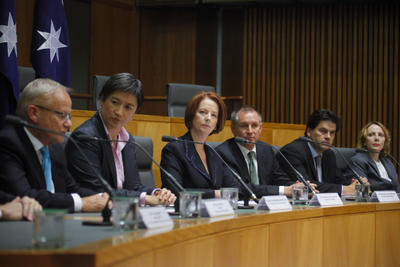Perhaps Canberra also took note of the late Indonesian strategist Hadi Soesastro when he remarked that in many westerns, it is the deputy sheriff who usually gets shot.
The wild west aside, Australia has always had a great deal of influence on Asia. Many of the Asian elite are Australian educated, and many middle-class elite migrated to Australia for their children’s education. A great number of them are now back in Asia, filling key positions as policy makers, business leaders and academics, and strengthening Australia-Asia ties.
In many ways, Australia is a perfect complement to Asia, an over-populated region with relatively scarce resources per capita. With vast natural resources and small population, Australia can prosper simply by exporting raw materials and services, and importing Asia’s manufactured goods. If water scarcity does not become a constraint, Australia will become an important source of food, wine, culture and education for an increasingly affluent Asia. And since Australia is already an OECD-level advanced economy with strong rule of law and social infrastructure, the country’s knowledge services will find ready markets in Asia.
But Australia-Asia relations in the 21st century — and Australia’s capacity to maintain these financial ties — will depend on two scenarios for Asia: one bright and one bleak. The mainstream view, more a linear extrapolation of current trends, is that Asia will account for more than half of global GDP and financial assets by 2050. By that time Asia will have many major economic powerhouses or regions, such as China, India, Japan, Korea, ASEAN, the Gulf states and possibly Central Asia. Australia will continue to prosper but its relative weight — and influence — will necessarily decline if Asian growth outpaces that of Australia.
By sheer force of a young population rising into the global market, with access to modern technology and a dose of above-average governance, Asia has a growth momentum that will not be easy to stop. But neither sustained good governance nor good weather is an historical inevitability, with the potential for internal conflict and external pressures an added complication. Hence, an alternative scenario cannot be ruled out.
This alternative scenario applies not only to Asia but also to the world. In 1972, the famous ‘Limits to Growth’ model showed the earth was running out of resources. In 2002, the authors completed a 30-year review and found nothing to change its scenarios. The 2007 review by an Australian CSIRO scientific researcher, Graham Turner, found that current industrial production, food production, population and pollution are all in line with the model’s projection of economic and societal collapse in the mid-21st century. Although the mainstream belief is that technology has the potential to avert such a scenario, the fact remains that many parts of Asia are already highly polluted, water stressed and highly vulnerable to climate change. In such a scenario, the sparsely populated Australian continent would be an island of relative peace and self-sufficiency in food and security, making it a natural sanctuary for refugees. This raises a different set of questions on defence and security management.
While these two scenarios pose significant questions for the future, the current financial relationship between Australia and Asia is not without its own issues. Australia has one of the most advanced financial systems in the Asia Pacific and emerged from the global financial crisis relatively unscathed, despite its closer financial ties with London and New York compared with Tokyo, Hong Kong, Singapore or Shanghai. This was thanks to prudent macroeconomic management and financial regulation, since Australian banks were highly concentrated, profitable and did not venture into the toxic derivative trade.
But the fact remains that Sydney and Melbourne have not become major Asian financial centres because their links with the continent are still relatively shallow. Presently, Australia finances its current account deficit mainly through the London and New York markets. The oddity is that much of the global savings placed there are now from those countries in Asia with current account surpluses. This circuitous route is particularly anomalous, although it reveals some interesting features.
First, despite being very advanced in the investment-banking field, no Australian financial institution has attained Goldman Sachs/Morgan Stanley class. This suggests that Asian investment banks are even further behind in the evolutionary process. Second, while Australian banks are thriving on a concentrated banking model that lives off a resource-based economy, they have not evolved on a regional basis. So, sound macro-prudential supervision is no substitute for innovative banking models that Asian counterparties can emulate.
Developing an innovative, prudent and stable financial system that serves the Asian real sector will be a serious challenge, especially given the failure of the Wall Street derivative model. Australia has the most advanced financial infrastructure in the Asia-Australasia time zone, but its financial institutions lack deep Asian connections through office branches and business relations. The desire to overcome this challenge speaks volumes about the scope for increased cooperation and integration during the coming decades.
Andrew Sheng is President at the Fung Global Institute.
This post is part of the series on the Asian Century which feeds into the Australian government White Paper on Australia in the Asian Century.

